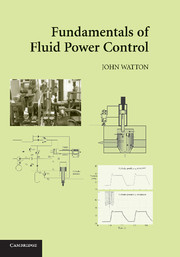1 - Introduction, Applications, and Concepts
Published online by Cambridge University Press: 05 June 2012
Summary
The Need for Fluid Power
In applications for which large forces, torques, or both are required, often with a fast response time, it is inevitable that oil-hydraulic control systems will be called on. They may be used in environmentally difficult applications because the drive part can be designed with no electrical components, and often they are the only feasible means of obtaining the forces required, particularly for linear actuation. A particularly important feature is that they almost always have a more competitive power–weight ratio when compared with electrically actuated systems, and they are the inherent choice for mobile machines and plants. Fluid power systems also have the capability of being able to control several parameters, such as pressure, speed, and position, to a high degree of accuracy and at high power levels. The latest developments are now achieving position control to an accuracy expressed in micrometers and with high-water-content fluids. In practice, there are many exciting challenges facing the fluid power engineer, who now must preferably have skills in several of the following topics:
Materials selection, water-based fluids, higher working pressures
Fluid mechanics and thermodynamics studies
Wear and lubrication
The use of alternative fluids, given the environmental aspects of mineral oil, together with the extremely important issue of future supplies of mineral oil
Energy efficiency
Vibration and noise analysis
Condition monitoring and fault diagnosis
Component design, steady-state and dynamic
Circuit design, steady-state and dynamic
Machine design and its integrated hydraulics
Sensor technologies
Electrical–electromagnetic design
Computer control techniques
Signal processing and associated algorithms
Modern control theory and artificial intelligence
- Type
- Chapter
- Information
- Fundamentals of Fluid Power Control , pp. 1 - 32Publisher: Cambridge University PressPrint publication year: 2009

